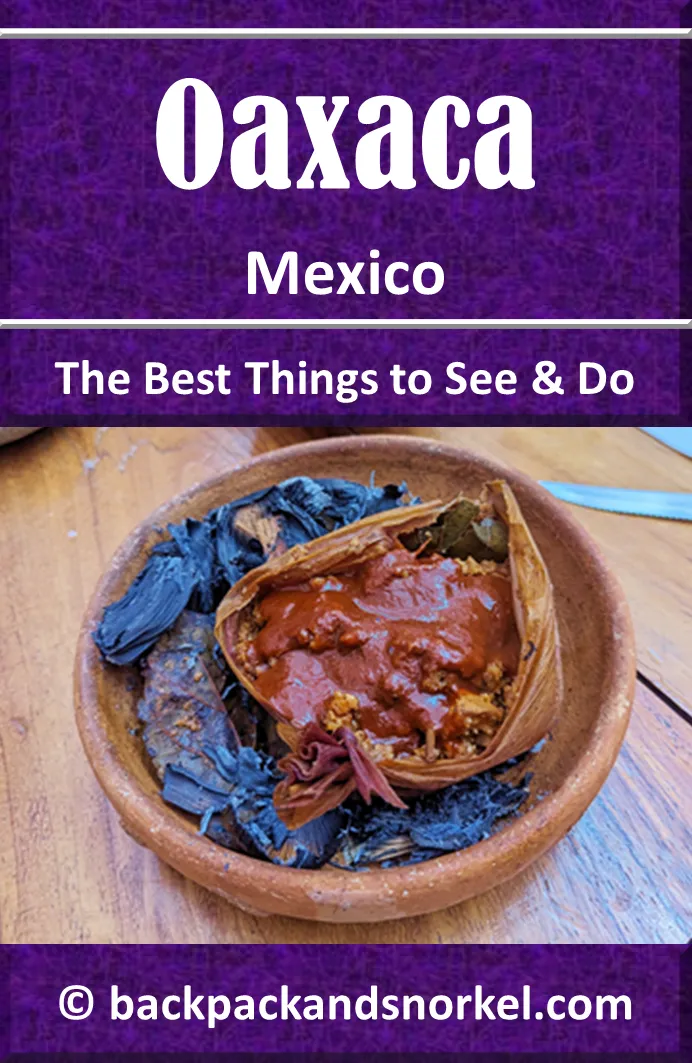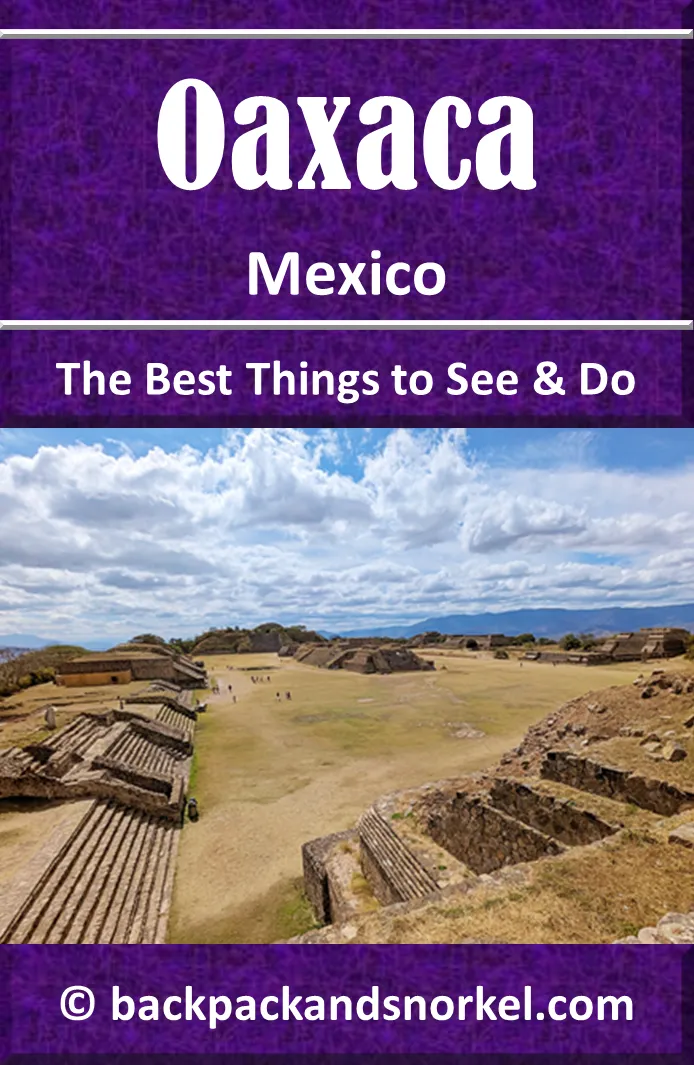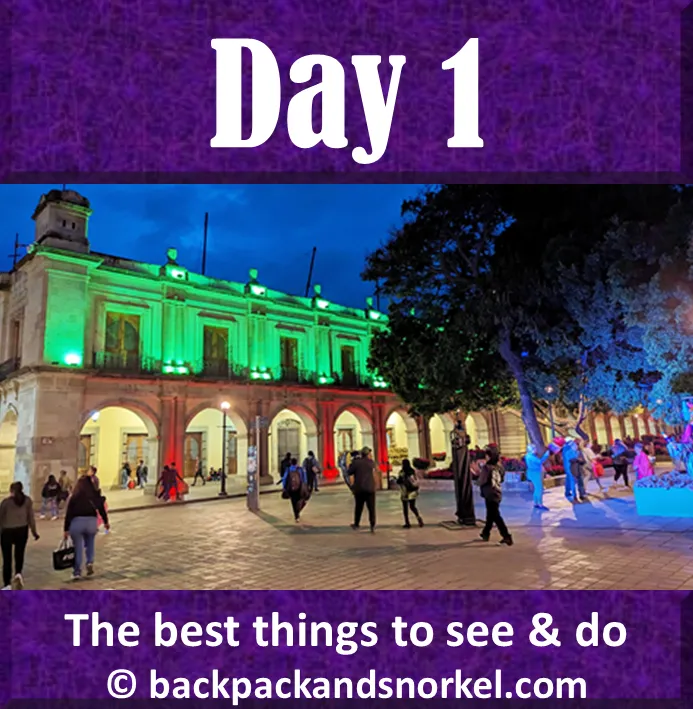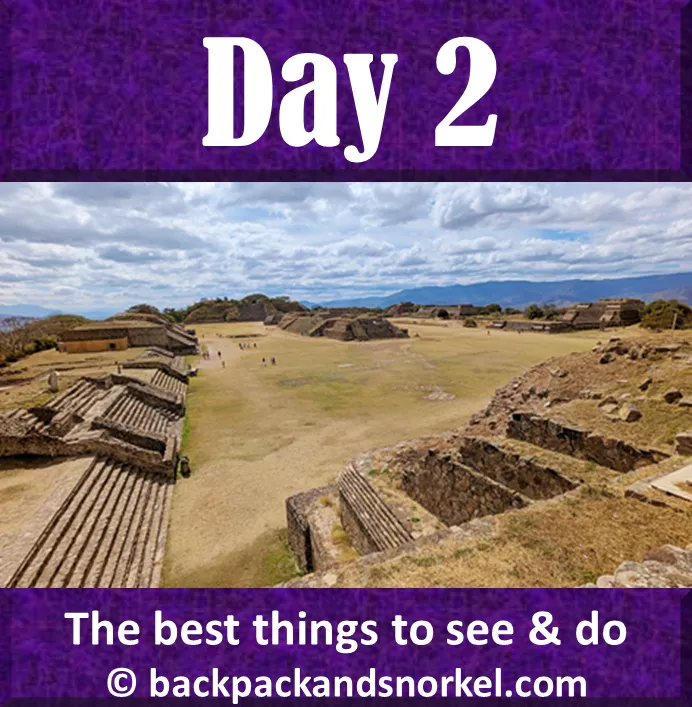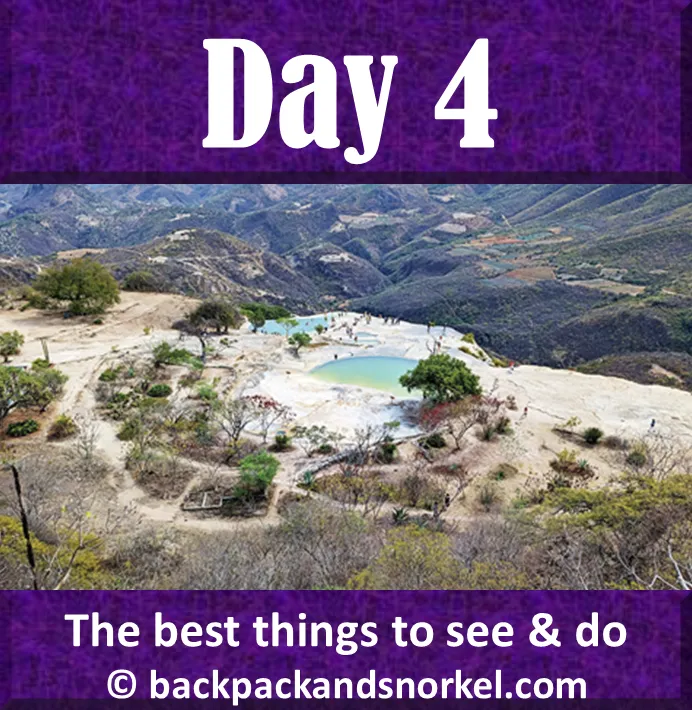Backpack and Snorkel Travel Guide for Day 2: Self-guided walking tour of Monte Albán the historic district in Oaxaca - Oaxaca Purple Travel Guide
Monte Alban was one of the earliest cities of Mesoamerica and an important socio-political and economic center of the Zapotec culture for about 1000 years. Today, it is the most important historic site in the state of Oaxaca. We provide detailed information and the best things to see and we show lots of photos so you know what you can expect.
Today is your first full day in Oaxaca. Start with the most important historic site in Oaxaca: Monte Albán. Afterwards, you have time to see the sites that you did not have time for yesterday and you can visit additional sites.
End the day with traditional Oaxacan food in probably the best restaurant in Oaxaca and finish your evening people-watching in the Zocalo.
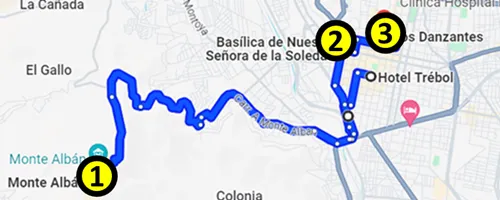
1 = Monte Albán
2 = Basílica de Nuestra Señora de la Soledad
3 = Los Danzantes
Here at Backpack and Snorkel Travel Guides, we typically promote self-guided walking tours.
But we realize that not everybody likes to walk by themselves in a foreign city. So, just in case that you rather go with ab guide: NO PROBLEM! Please see the free GuruWalk and paid Viator tours below.
free GuruWalk tours
paid Viator tours
Self-guided walking tour of Zona Arqueológica de Monte Albán
At 6,400 ft (1940 m) above sea level, on an artificially leveled ridge, about 6 miles (9 km) east of Oaxaca, lies the archaeological site of the Mesoamerican city Monte Alban.
Founded around 500 BC, Monte Alban was one of the earliest cities of Mesoamerica and it was an important socio-political and economic center of the Zapotec culture for about 1000 years, much longer than other well-known cities like Teotihuacan and Tikal and nearby Mitla and Yagul.

Unfortunately, Monte Alban was abandoned around 500 – 750 AD, which was long before written historic records were produced and thus the original name of the city is unknown.
Even the origin of today’s name, Monte Alban, is not known. It is believed that it may originate in a corrupted native Zapotec name, or be a reference to a colonial-era Spanish soldier by the name of Montalbán, or even to the Alban Hills of Italy.
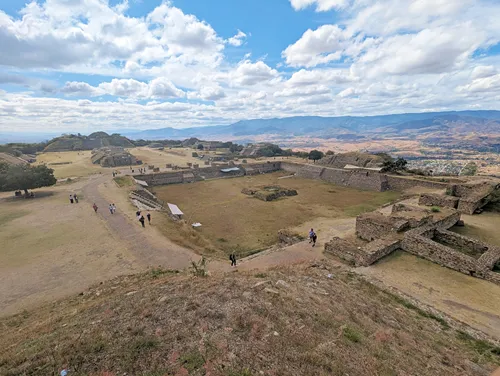
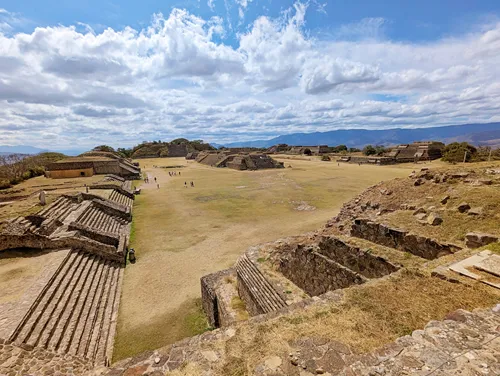
Early excavations at Monte Alban happened in the 19th and very early 20th century, but it took until 1931, until large-scale scientific excavations were performed. Most of what you see today was reconstructed during that time.
More excavations took place in the 1960s and 1970 and there are more excavations ongoing in the 2020s.
Excavations have shown that the site of Monte Alban was uninhabited before 500 BC. It was situated in no-man’s land between several smaller cities in its vicinity that regularly engaged in warfare with each other.
At around 500 BC, Monte Alban was founded on an easily defendable ridge on the no-man’s land and its population rose quickly to about 5,200 by 300 BC, likely by migration from some of the smaller cities who seemed to have lost a similar amount of people. Indications are that Monte Alban was intentionally built as a Zapotec capital. It also appears that one of the smaller cities, Tilcajete, might have actively opposed to be incorporated into the increasingly powerful Monte Alban.
At around 150 AD, Monte Alban’s population appears to have been around 17,200 people, making it one of the largest Mesoamerican cities at the time.
With rising influence came the desire for more power and indications are that the city expanded its reach through warfare and colonialization.
During the Monte Albán IIIA phase (200 BC – 500 BC), Monte Alban was the capital of a major regional political force that dominated the Valley of Oaxaca and across much of the Oaxacan highlands and had contacts to Teotihuacan.
During the Monte Alban phase IIIB/IV, the power of the city declined and Monte Alban was largely abandoned at around 800 AD.
Only small-scale reoccupation of some parts of the city and opportunistic reuse of earlier structures were found thereafter.
Self-guided walking tour of Monte Albán
The following map shows the destinations on your self-guided walking tour of Zona Arqueológica de Monte Albán:
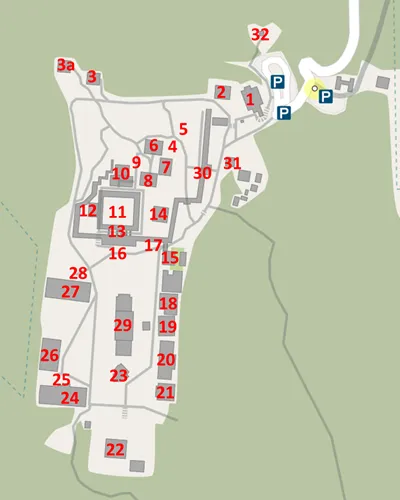
1 = Visitor Center
2 = Building X
3 = Tomb 104
3a = Residence Tomb 103
4 = VG Complex
5 = El Palacio del Ocote
6 = Building D
7 = Building VG
8 = Building E and Stela VGE-2
9 = Temple of Two Columns
10 = Building I
11 = Patio Hundido / Sunken Patio
12 = Building B
13 = North Platform
14 = Building A
15 = Ballcourt
16 = Stela 9
17 = Stela 15
18 = Building II
19 = Building P
20 = Palace
21 = Mound Q
22 = South Platform
23 = Building J / Observatorio
24 = System M
25 = Galeria de los Danzantes
26 = Building L / Building of the Dancers
27 = Building IV / Building K
28 = Stela 18
29 = Buildings G, H, and I
30 = Jewelled Platform
31 = Tomb 56
32 = Tomb 7
Start your self-guided walking tour of Zona Arqueológica de Monte Albán at the visitor center where you buy your admission tickets.
1) Visitor Center
Before you visit the site, spend a few minutes looking at the exhibits in the visitor center. On display are treasures that were found inside the pyramids and tombs, and carved stones that were brought here to be protected from the weather.
The visitor center also has restrooms, a restaurant, and shade.
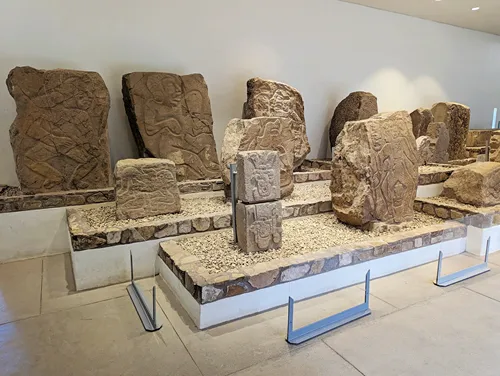
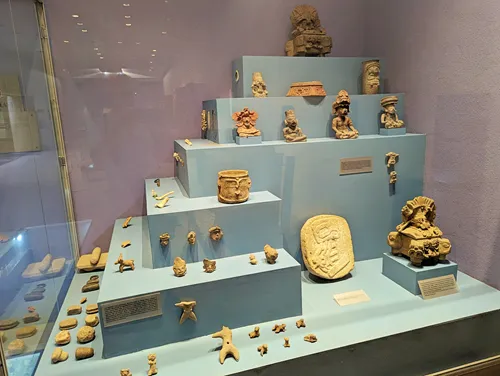
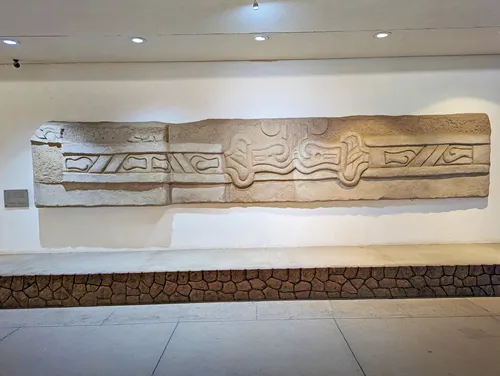
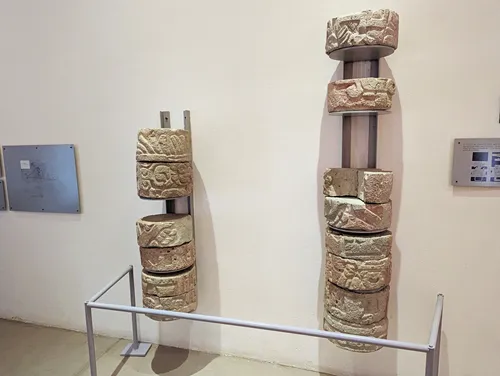
Now exit the visitor center, go through the entrance gate, and follow the path to your right.
2) Building X
This enclosure is a perfect example of the superposition of architectonic structures common to Mesoamerica. Part of a platform was removed with the remains of this temple, which permitted the discovery of an earlier construction. The adobe and stone fill, in addition to the quality of the stucco floors, prevented its destruction. To preserve it, new adobes were used, made with the same earth.
In this way, this ancient construction system is maintained and preserved. The lower building dates from Period Il (100 BC – 350 AD), and the upper one from IIIB-IV (500 – 800 AD).


Continue on the path and to Tomb 104.
3) Tomb 104
Tomb 104 was an elegant residence of one of the prominent citizens of Monte Alban. The walls surrounding the home are grouped around a central patio and the tomb inside was colorfully painted with priests bearing gifts. Numerous clay artifacts were found in the tomb. The entrance to the tomb is sealed.
A reproduction of the tomb can be found in the National Museum of Anthropology in Mexico City.

3a) Residence Tomb 103
In contrast to other residences in this city which houses single tombs in their interiors, this structure contains at least four tombs (tombs 110, 112, 103 and an unnumbered tomb), granting the structure the character of a family crypt. The principal tomb has polychromic painting, and its entrance faces west. This habitation has entrances facing the four cardinal points and some groups of rooms with their own patios.
Nearby are numerous smaller residences with simpler burials, forming an authentic necropolis of the centuries from 500 AD – 800 AD (Period IIIB-IV).

Now backtrack your steps. Shortly before you get to 2) Building X, you will see a path go up the hill to your right. Follow it uphill and you will see the buildings of 4) VG Complex in front of you.
4) VG Complex
The Geodesic Vertex (Vértice Geodésico or VG) is a modern, topographic measuring point, marked by a bronze benchmark and used by government agencies for mapping.
The four temple platforms delimit a ceremonial complex of period IIIB-lV (500 AD – 800 AD). To the north, east and south Sides are Buildings D, VG and E high platforms which supported temples with adobe walls. To the east is the Temple of Two Columns; the columns, made of a stone not found locally at Monte Alban, display bas-reliefs of the ‘God of the Wide Beaked Bird’ and supported a roof.
We will start exploring VG Complex in a few minutes.
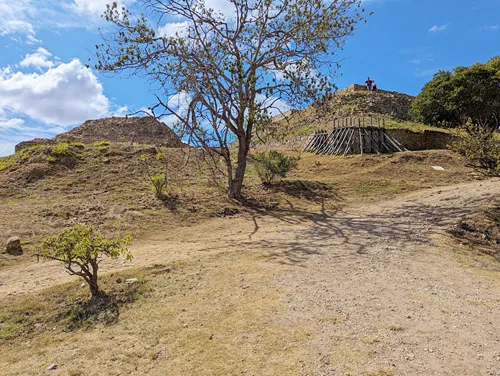
First, however, turn left.
5) El Palacio del Ocote
This complex formed part of the most exclusive residential areas of the Northern Platform. The Palace is composed of a central patio surrounded by groups of rooms, which vary in size. Its dimensions and large number of dwellings suggest that the Palace was occupied by a large group of high social rank. Instead of a tomb, there is an altar; this anomaly indicates the complex had a ceremonial character. Its architectural remains date to the years 300 to 600 AD.
Today, only the foundations of the palace walls remain in existence. The dwelling once had a flooring of limestone, and sand, which were painted red; the ceilings, probably made with beams and other materials, have disappeared over time.

Now turn around and walk up the hill to 4) VG Complex, with the two pyramids to your left. You will now enter the VG Complex.
6) Building D
Building D is the northernmost building of the VG Complex from the period IIIB-lV (500 AD – 800 AD).

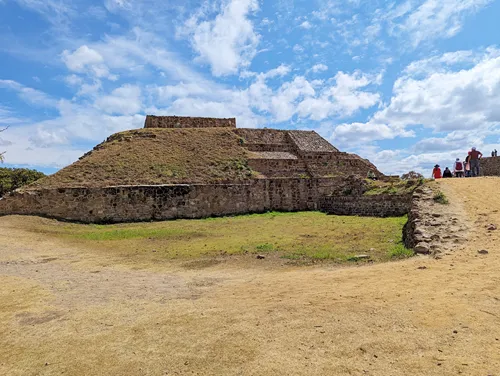
You can climb up for a beautiful view of the VG Complex.
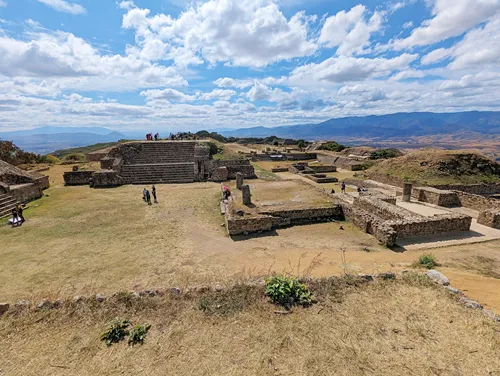
7) Building VG
Buidling VG is the easternmost building of the VG Complex of period IIIB-lV (500 AD – 800 AD). It is off-limits for climbing up.
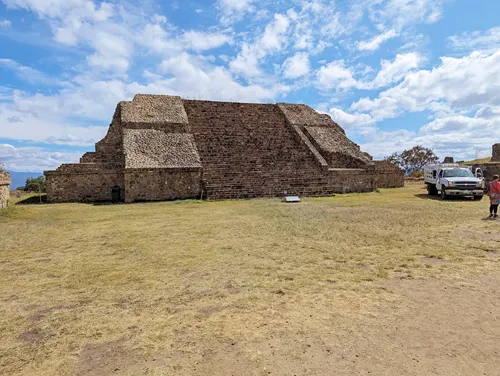
8) Structure E-Sur and Stela VGE-2
Building E was enlarged towards the south during period IIIB-IV and a stairway was constructed from the North Platform surface to the top of Building E where a southerly facing temple was built.
A large stone slab, or stela, was erected on a platform in the stairway and carved with representations of individuals of Monte Albans governing class. Four of the five individuals are female, and each person is shown with his calendric and personal name. The principal figures, an elderly woman and a younger man depicted as a jaguar, are engaged in a ritual possibly related to the transfer of power between generations.
The other three women may be relatives.
Late period IIIB-IV: 800 AD
You can climb up for beautiful views of the VG Complex and the rest of Monte Alban.
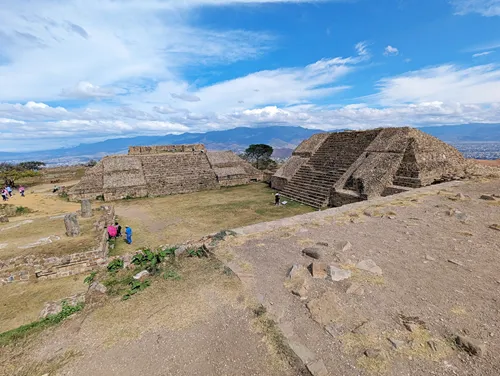

You will come back later to the base at the southern end of this building for a better view of the stela.
9) Temple of Two Columns
It is of period IIIB-lV (500 AD – 800 AD). The columns, made of a stone not found locally at Monte Alban, display bas-reliefs of the ‘God of the Wide Beaked Bird’ and supported a roof.
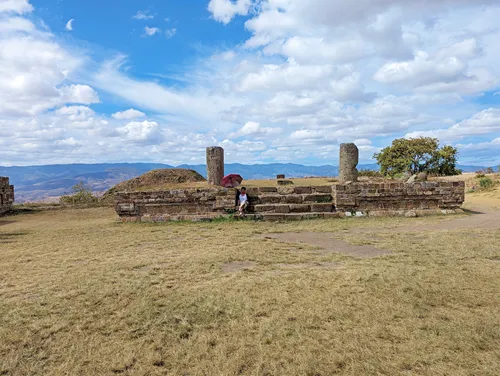
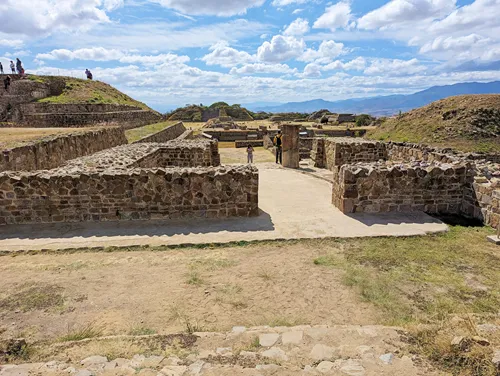
10) Building I
During the exploration of this structure, an attempt was made to identify the temporal sequence of the construction stages. The majority of its architectural elements have been left just as the archaeologist found them. Little has been done to protect and study this building, consequently, it is not to be climbed by the public for fear that the fragile walls could collapse.
Only traces remain of the temple on the upper surface, with a box at the entrance which contained an offering from Period IllB-IV (500 AD – 800 AD).

Now go down the stairs towards the large, enclosed space, the Sunken Patio.
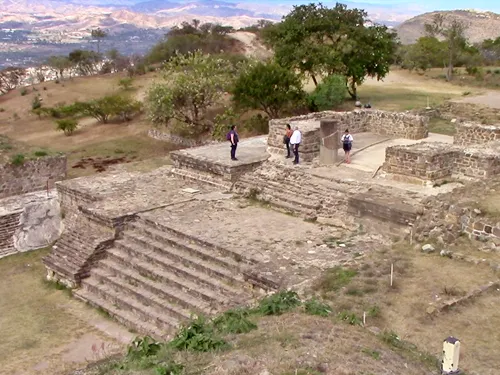
11) Patio Hundido / Sunken Patio
The Sunken Patio is 164 ft x 164 ft (50 m x 50 m) is an enclosed area which has an altar in the center where the high priests performed rites and ceremonies.


12) Building B
This temple displays at least three construction stages, of which the oldest is represented by a temple with walls of painted red stucco vertical stones. It corresponds to Period IllA (350 AD – 500 AD) or early IIIB-IV (500 AD – 650 AD).
Later, the facade (stairway, balustrades, and walls) was widened; the back section remained the same and a temple, of which only the foundation remains, was built on top.
During Period V (800 AD – 1521 AD), the southern and western sides of the building were partially covered with walls in which spaces between stones were filled in with horizontal stone slabs.
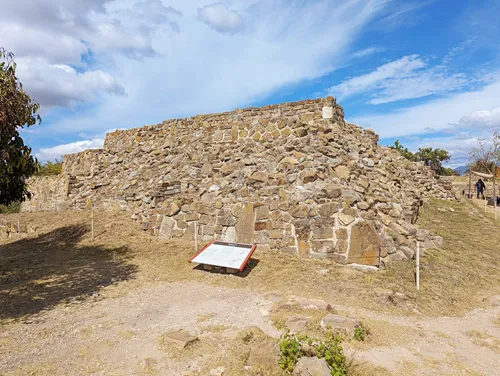
13) North Platform
This acropolis-like architectural complex is one of the most complicated and ancient systems of the city, both because of its dimensions and intricate number of buildings and patios, as well as for the interconnecting accesses.
It was constructed and remodeled over centuries to satisfy the needs of the users. Thus the impressive portico supported by twelve columns, which provides access to the sunken patio, offers an idea of the type of activities which were reserved for one of the dominant elites of city.
Period IllB-lV (500 AD – 800 AD).
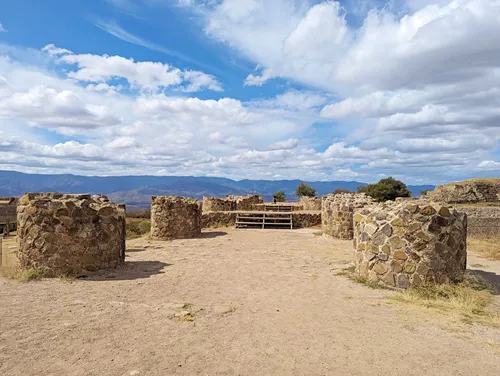
14) Building A
In contrast to the majority of the structures at Monte Alban, this building does not show evidence of stages prior to Period Ill; only the stairway was remodeled. Like the other buildings, it served as the platform for a temple. The tablets decorated with cornices of ‘double scapular’ type completely surround the base of the structure. It corresponds to Period IIIB-IV (500 AD – 800 AD).
The reconstruction of the upper portion was based on internal retaining walls since the external walls had been lost. The Southeast corner shows stepped walls which form the core of the of the structure.
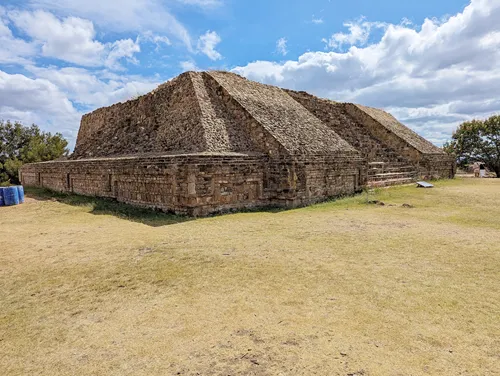
Now look to your left and you see the southern end of 8) Building E and Stela VGE-2.
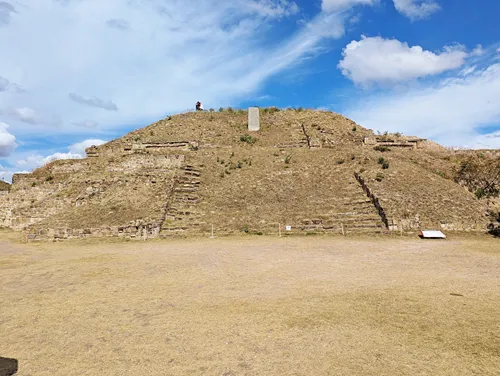
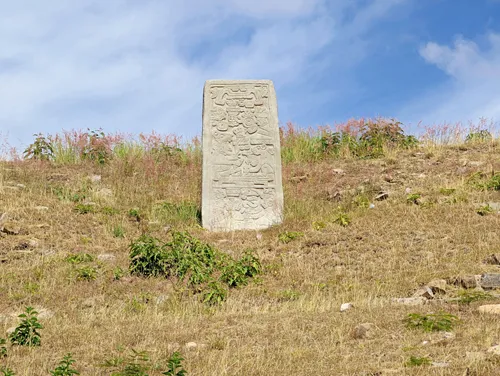
Now walk right (east bound) towards the stairs.
15) Ballcourt
In this game, the movement of a rubber (or hule) ball represented the path of the sacred heavenly bodies: the sun, moon, and Venus.
The prize bestowed upon the winner of the game was support and protection by the gods. The game took place on the floor level of the court. Hitting the ball with hips, elbows, and knees, players passed it from one end of the ballcourt to the other.
Sloping walls at the sides of the court were covered with a thick mixture of lime to give them a polished surface from which the ball, if it landed there, would slide down and back onto the court's floor.
The disk located in the center of the wall was probably the key to gaining points in the game.
Up to this time, there have been no discoveries in Monte Alban which would suggest that human sacrifice was practiced in association with the Ballcourt, although in other parts of Mesoamerica, this has been found to be the case.
In Monte Alban five ball courts were constructed, which confirms the importance of this activity at a regional level.
The ballcourt was constructed at approximately 100 BC.

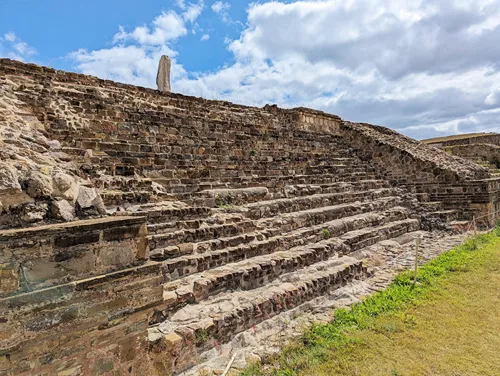
16) Stela 9
Originally discovered by Leopoldo Batres at the beginning of the 20th century, this stela is also referred to as an obelisk due to the point at its upper extremity. The four side panels display remarkable glyphs.
This piece is similar to Mayan stelae and is one of the most important in Monte Alban. Given its location, this stela is almost certainly associated with events that took place on the North Platform.
On its southern side we can observe a richly adorned male character whose name is possibly represented in the lower part with the glyph ‘8 Flower’.
On the eastern side, there appear two persons with large plumes adorned with chalchihuites ('precious stones') who probably are priests since they carry bags of copal. A glyph representing ‘word' is in front of their faces.
On the western side there is a richly dressed priest with a word glyph and a cluster of other glyphs that refer to important dates that relate to him.
The north side contains the most important inscription showing two people with their respective names over their heads. One figure is talking and the other is listening.
Underneath them is a narrative exposition of numerical and symbolic glyphs possibly representing an important period of government.

Behind the Stela is the 13) North Platform that you previously walked on.
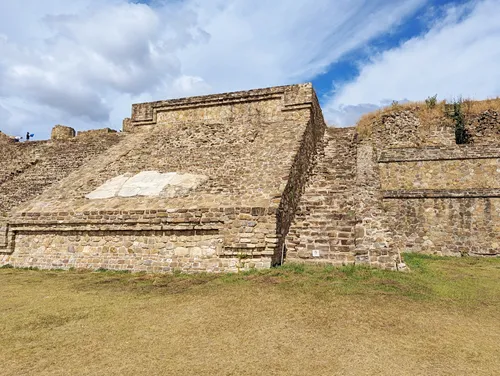
Trace your way back almost to 15) Ballcourt. Shortly before you get there, you see your next destination to the left.
17) Stela 15
This unique horizontal stela shows one of the few narrative texts that has been found in its original location, probably because it was built during the late occupation of Monte Alban IIIB-lV (600 AD – 800 AD).
The carvings on the monolith include a scene, two short texts, and several isolated glyphs, in which calendrical names and members of the ruling nobility may be identified.
The texts begin with a year glyph and year bearer. Apparently the central text refers to the ritual depicted in the scene where a Monte Alban ruler named ‘5 Reed’ intervenes. The figure, with a nose ornament and reclining on a long piece of furniture, dedicates an offering, while a shaman called ‘7 Escobilla’ (Soap Plant), transformed into a bird, is presented with a prisoner. Another individual with a nose ornament called ‘6 Earthquake’ is seated to the left. It seems to establish the genealogy of Lord ‘5 Reed’.
It is possible that the monument commemorates his ascent to power, legitimates his line of descent, and celebrates a military victory through the ballgame and the sacrifice of a prisoner.


18) Building II
During Period lI (100 BC – 350 AD), this was a high platform topped by a temple with rectangular columns. A strairway led to the platform to the south, and the entrance to a tunnel connecting to the altar in the Main Plaza.
The facade of the building was extended during Period IIIB-IV (500 AD – 800 AD) and the stairway and the ‘double scapular’ cornices were remodeled.


19) Building P
This is another platform. A unique feature is the light chamber formed by a narrow chimney in the stairway, supposedly used to record the passing of the sun when it was at the zenith. This phenomenon occurs twice a year and was significant for the Zapotec calendar.
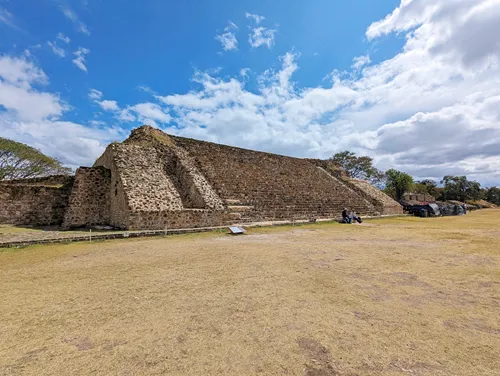
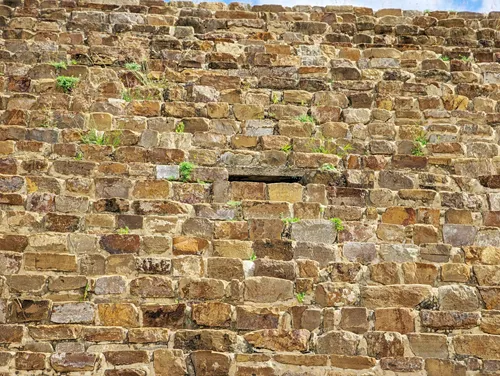
20) Palace
Constructed around the years 350 to 800 AD, this palace is one of the most outstanding in the Great Plaza. It may have been occupied by persons within the noble or priest class.
At its entrance is a narrow pathway known as a ‘blind entrance’, which indicates the restricted and exclusive character of the building. Due to this characteristic, the palace is thought to have functioned as a temporary residence.
At the center of its patio is a small altar. At one side of the patio is a tunnel which runs below the palace. The tunnel has not been completely explored; however, it may have functioned as a private entrance to the Great Plaza and other bordering areas.
Today, only the defiant walls of the palace are preserved. The rectangular block of stone which crowned the doorway is a small example of the advanced architectural character of the building, as well as the great economic and political power of the ruling classes of Monte Alban.
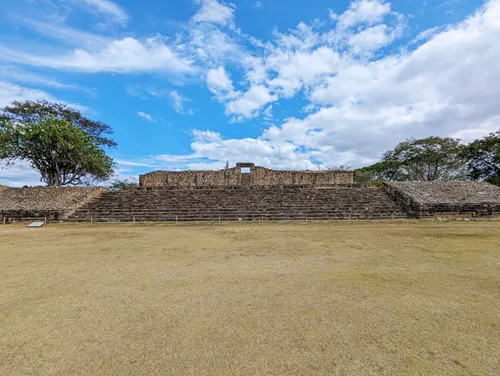
21) Mound Q
This pyramidal platform is one of the simplest structures on the Main Plaza of the city. The only remains on its upper part are of a small room, probably a temple.
It is unexplored and nothing more is currently known about this structure.
Mound Q was built between 500 AD and 800 AD (Period IIIB-IV).
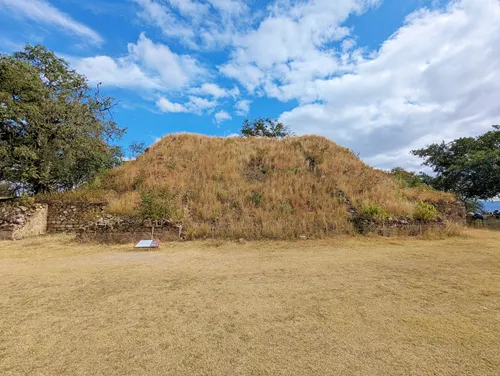
22) South Platform
The imposing artificial mass of this Platform to the south of the Main Plaza reflects the importance of this cardinal point.
The 131 ft (40 m) wide stairway leads to a patio and two pyramidal platforms, one being the major structure on the north-south axis of the city and another, smaller one, located towards the southeast.
Older carved stones were reused in the corners of the South Platform constructed during Period IIIB-IV (500 AD – 800 AD).
The defensive wall, constructed on top the platform after 800 AD, is notable in that it limited access to the platform from the north.
You can climb to the top of the South Platform for beautiful views of Monte Alban and the Oaxaca Valley.


23) Building J / Observatorio
Building J is characterized by its irregular form - suggesting an arrowhead - which departs from all lines and axes existing in the rest of the Main Plaza's architecture and periferal complexes of Monte Alban.
According to recent investigations, the building is related to other points of observation in Monte Alban and its surroundings. Among the pre-Hispanic Zapotec groups, astronomy was a daily activity with an extremely important function in urban planning.
The access of this building was apparently limited to a few scientist-priests and persons of high political and social power. It was constructed around 100 BC.
Daily astronomical observation probably enabled the prehistoric society of Monte Alban to calculate agricultural cycles, to predict seasonal changes, and to determine the proximity of the rainy season, as well as the time to collect medicinal plants; also as a result of these observations, prophesies were made and constructions, streets, avenues, and plazas were oriented towards the cardinal points.
A small group of educated men, among the class of priests, who received a disciplined religious education since childhood, practiced astronomical observation. Their abundant and precise knowledge was a priceless factor in the development of state power.
Within the Main Plaza, two buildings served as astronomical observatories: Building J and Building P.
These are related in nature to buildings of other sites in the Oaxaca Valley such as Caballito Blanco in Yagul.
They were associated with - in proximity and visually - natural phenomena, such as hills, rocks, and ravines, and/or manmade markers, such as stelae or carved stones.
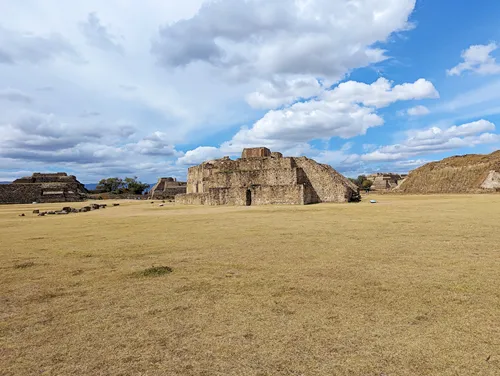

24) System M
The temple is represented by stone foundations for the adobe walls, which perhaps supported flat roofs made of wood beams and earth. The door opens towards the square patio and walls to provide privacy and preventing views from the outside in. Access from the Main Plaza is via a platform with stairs on both sides.
The central altar probably was used for making sacrifices or offerings.
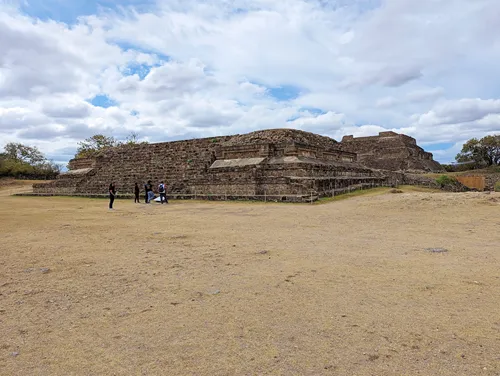
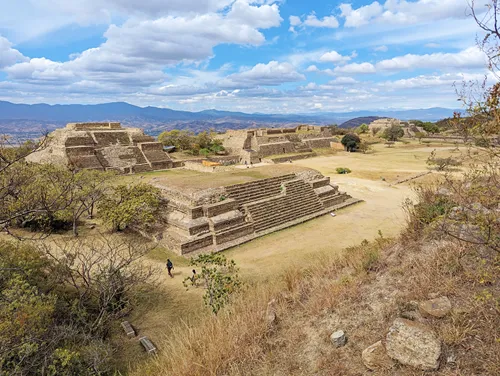
25) Galeria de los Danzantes
Here we find numerous carved stones with distinct human figures in dynamic positions. They have several characteristics in common: they are nude males, the majority obese with a wide nose and thick lips. These features suggest an Olmec influence.
Recent interpretations of the bas-reliefs found here view the figures as rulers or leaders from neighboring towns around Monte Alban, who were captured and offered as sacrifices. There is marked symbolism of the castration of the figures and the collection of blood, perhaps to offer to the gods or perhaps for use in fertility rituals.
The wall adorned with these vertical sculptures (dancers) and also with horizontal sculptures (swimmers) may be a kind of sequential text to be read by visitors to the building. The presence of symbols and numerals on the different stones narrate historical events that occurred in that era. Several centuries later, the Zapotecs dismantled the Wall and the different bas-reliefs were scattered throughout the site, to be used in future buildings. The roofed portion of the Wall is all that has been conserved without subsequent alterations.
As a conservation strategy, copies were made of the detached sculptures and the originals were moved to the Monte Alban on-site museum.

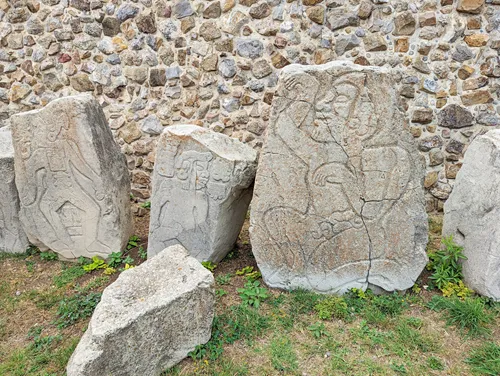
The reliefs on this wall are the city's earliest examples of sculpture and they date to Monte Albah I (500 BC – 200 BC). This area displays human figures carved in a range of dynamic positions which is why they were called dancers at the end of the 19th century, associating them with dances from indigenous communities.
They share certain features: they show naked male figures, most of them obese, with a broad nose and thick libs, which have been attributed to the influence of Olmec culture.
The more current interpretation of these reliefs is that they represent rulers or leaders of towns neighboring Monte Alban who were captured in battle and killed in sacrifice. There is a clear emphasis on castration of the figures and the spilling of blood perhaps to offer it to the gods or to use it in a fertility cult.
The wall decorated with these vertical (dancer) and horizontal (swimmer) sculptures would be equivalent to a text in a sentence to be read by the building's visitors. The glyphs and numerals on the stones refer to historical events that took place that time. Centuries later the Zapotecs themselves dismantled part of the wall and the different reliefs were scattered throughout the site to be re-used in other constructions.
The roofed portion of the wall in the only one that was preserved without changes in subsequent periods.
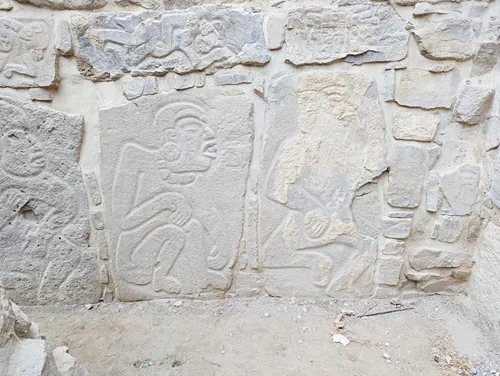
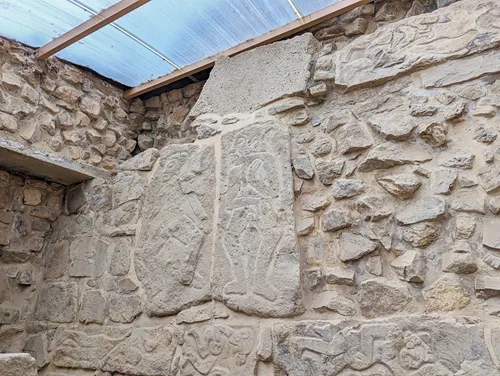
26) Building L / Building of the Dancers
The palaces within the Great Plaza could have had two distinct functions: as residential spaces or as administrative and ceremonial spaces; perhaps this latter function characterized the residence located above Building L.
This complex was constructed between the years 300 AD and 800 AD, and it consists of a central quadrangular patio lined by dwellings. During its occupation some of the rooms were modified - some enlarged and others divided - perhaps to fit the requirements of its inhabitants.
A pair of tombs (60 and 69) is located to the sides of the building, near the palace. Since it is uncommon in Monte Alban to find tombs outside of a house, this could suggest that the construction belongs to older construction periods.

27) Building IV / Building K
This ceremonial complex (temple-patio-altar) is a twin to System M and corresponds to Period IIIB-IV (500 AD – 800 AD). The temple platform with its stairway and flanking balustrades, has various bodies of ‘talud y tablero’ (slanted and vertical wall) and the tableros show a ‘double scapular’ type decoration. The niche located in the center of the base of the stairway was perhaps used to place offerings. The entrance to the patio is from the Main Plaza by way of the stairway of Mound N. There is a large sloping earlier wall inside Building IV (Period l, 500 BC - 100 BC) and the temple inside the Northwest corner is from Period Il (100 BC – 350 AD).

28) Stela 18
Ancient Zapotecs used Stela 18 as a sun dial to tell the time. By observing the shadow the Stela cast on the ground, the people were able to predict when it was midday.
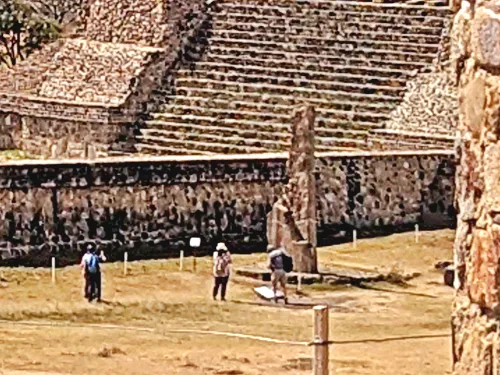
29) Buildings G, H, and I
The platforms for three temples comprising this grouping were built over a natural rock outcrop beginning in Period Il (100 BC – 350 AD). Building H, in the middle, is the largest and in Period Il or IIIA (350 AD – 500 AD) had its access on the west side. During Period Ill-IV (500 AD – 800 AD) the west entrance was closed so that the stairway and the temple remained facing east and towards the altar in the plaza.
The side temples, G, and l, facing north and south, respectively, were built and modified in Periods Il, III and lIIB-lV.
Those buildings cannot be climbed as they are actively excavated by scientists.
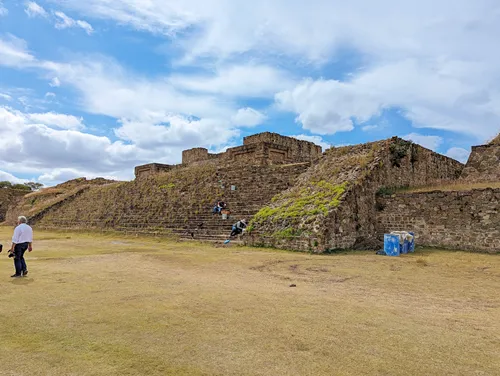
Now walk back to 15) Ballcourt, climb up and walk north towards the exit.
30) Jewelled Platform
This platform was named for its ornamental vertical panels (tableros). These tableros were decorated with stone disks covered with stucco and painted red.
Ornamentation of this type is found on only two other buildings of Monte Alban.
This platform with temple is distinct from others in the manner that it leads directly into the great Northern Platform; other constructions of this site are more independently situated.
During exploration of this building, an important collection of Teotihuacan-type ceramics was found, as well as a possible workshop of mica. These findings suggest the possible presence of a Teotihuacan population in Monte Alban between the years 300 and 600 AD, in the same manner that a Zapotec population existed in Teotihuacan.

31) Tomb 56
Near the great ceremonial monuments of Monte Alban, the most luxurious (palace-like) houses of the city may be encountered; these were constructed of stone, mud, adobe, lime and sand. The residence which corresponds to Tomb 56 was occupied between the years 300 and 500 AD, the era of greatest urban development in Monte Alban.
The main rooms of this house are located on the northern, western, and southern sides of the central patio. The small tomb shows on architecturally advanced refinement, with Walls of cut stone, roofs of great stone slabs forming on arch and with only one niche in the far wall, where offerings were placed.
For the ancient Zapotecs, death was an important issue. When a person was buried, the deposited offering could be made up of objects manufactured from clay, stone, shell jade, bone, gold, silver, etc. The number of objects, the quality of their materials and their level of elaboration varied according to the importance and social rank of the individual. The current Mexican tradition of placing food and offerings for the dead comes from this type of prehistoric customs.
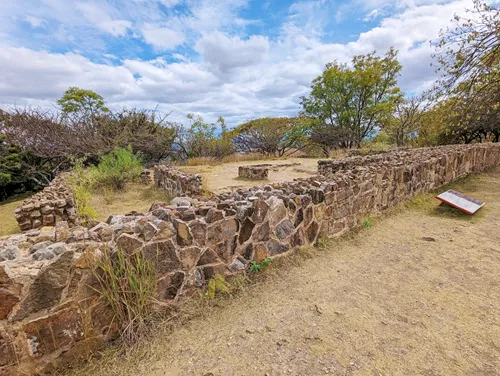
Now you can exit the site and walk back to the parking lot.
The last sight to see is actually not inside the protected area. It is right near the parking lot where everybody can go, even without a paid admission ticket.
32) Tomb 7
Tomb 7 is probably the best-known tomb of Monte Alban. It is a Zapotec tomb from the Classic period that was reused in Postclassic times for the burial of Mixtec elite individuals. Archeologists found some of the most spectacular burial offerings of any site in the Americas in this tomb. The contents can now be found in the Museum of the Cultures in Oaxaca City.
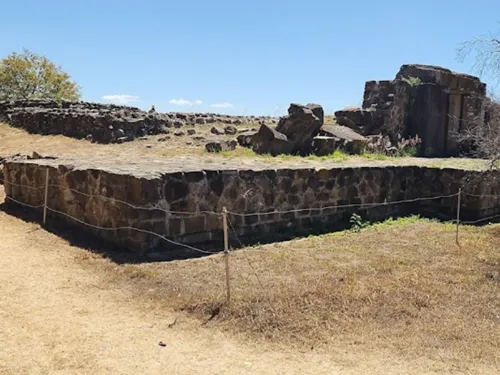
This ends your tour of Monte Alban. Now drive back to Oaxaca City where your next destination is waiting for you.
Basílica de Nuestra Señora de la Soledad
The basilica was built from 1682 to 1690 in baroque style and in the shape of a Latin cross. To better resist earthquakes, low spires and towers were intentionally built.
The current facade was built from 1717 and 1718. As with many other buildings in Oaxaca, green cantera stone was used.
The baroque pipe organ dates back to 1686 – it was restored in 2000.




Los Danzantes
Los Danzantes is one of the best restaurants serving traditional Oaxacan food in Oaxaca. It is imperative that you make a reservation several days in advance.
We definitely recommend trying the mole sampler appetizer. It comes with five different moles: Yellow Mole, Mole Manchamanteles, Red Mole, Mole de Luto, and Black Mole.
To make a long story short: the food is delicious, the atmosphere is great and the service is outstanding. We think the restaurant is worth every Peso we spent there.
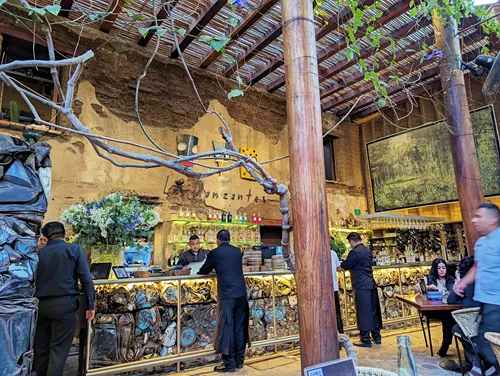
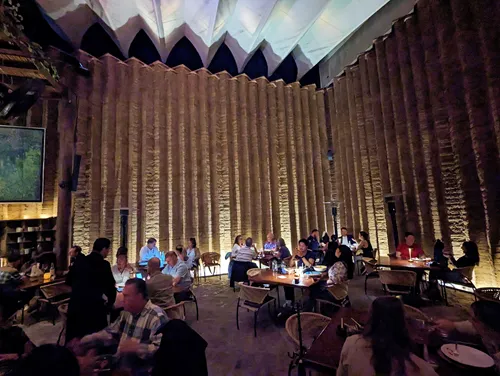


Where do you want to go now?
Author: Rudy at Backpack and Snorkel
Bio: Owner of Backpack and Snorkel Travel Guides. We create in-depth guides to help you plan unforgettable vacations around the world.
Other popular Purple Travel Guides you may be interested in:
Like this Backpack and Snorkel Purple Travel Guide? Pin these for later:
